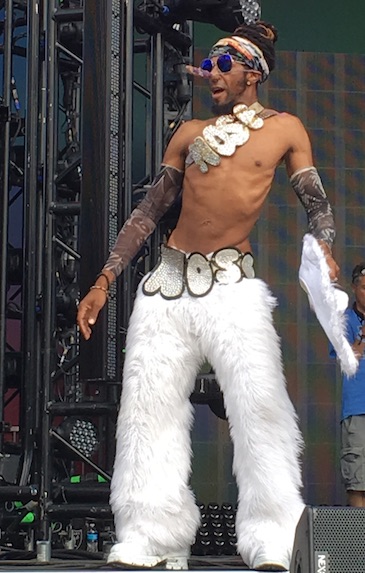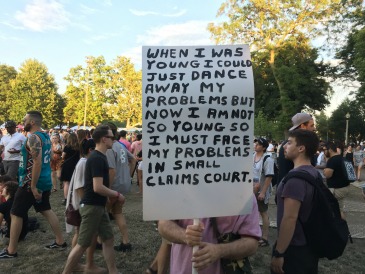Photos: A Tribe Called Quest Brings The Stripped-Down Heat To Pitchfork Day 2
By Tankboy in Arts & Entertainment on Jul 16, 2017 5:00PM
We headed into Day Two of the Pitchfork Music Festival armed with the happy news that organizers had opened a second entry gate, near the corner of Randolph and Ogden, to help alleviate the long entry lines many people faced on Friday. This was an especially welcome move since Saturday's attendance at Union Park felt far heavier, earlier in the day, than on Friday. Despite the denser crowds, Saturday still felt surprisingly navigable once you go into the park, and we used the opportunity to wander around and take in more of what Pitchfork has to offer, including stumbling across a conversation between Chicago writer Britt Julious and festival artist Mitski outside the Book Fort. (We even finally happened upon one of those much-loved, but ever-elusive—at least for this year—Don't Fret signs.)
That live chat was a good reminder that while the central focus is the music, you should always carve out wandering around time to visit the Fort, CHIRP Record Fair, the art of Flatstock, and various other booths and pop-up events on the grounds. And if you've got kids, you really should stop by the new Kids Area—you have to search it out in a corner of Union Park but it's worth it for all the fun, music-making machinery.
A Tribe Called Quest’s Q-Tip took the stage saying, “We ain't got no disco balls or that shit,” a reference to the previous evening’s headlining act. Instead it was simply Q-Tip, DJ Ali Shaheed Muhammad and a lone empty mic for Phife Dawg, who passed away last year. The visuals were minimal and the focus was on the group and their sprawling catalog.
The set was built to please, stocked with all the band’s hits, plus solo turns and members' various guest-appearances verses, including tastes of “Vibrant Thing” and Kanye West’s “Spaceship.” About an hour in, the beatboxing commenced, and Q-Tip got playful, throwing in “”No one does this any more [beatbox break] I'm really showing my age," then rapped an intro leading into “Bonita Applebum.” And then “Check The Rhime” popped in and it really clicked.
Th encore opened with “Can I Kick It?” And that just upped the joy, moving bodies all around me. By this point I was far removed from the stage but I was feeling the most connected to the music. And then Tribe dropped “We the People…” off last year’s We Got It from Here... Thank You 4 Your Service and all of a sudden the power and thunder of the band’s past met with their anger and frustration with the present. This was protest music, and it felt fiery and electric and important.— Jim Kopeny / Tankboy
The field was packed on Saturday, photo by Jim Kopeny / Tankboy
PJ Harvey’s set was built mostly on material from last year’s The Hope Six Demolition Project, but the recent cuts didn’t mean her performance didn’t feel timeless and epic. She and the band took to the stage like a marching band bringing in the end of times, and the apocalyptic feel remained throughout much of the show. Harvey herself is impossible to take your eyes off, from every twitch and vocal acrobatic—across the stately “The Ministry of Defence” through the dark swagger of “Medicinals”.
Harvey avoids much of her earlier material live, and we can’t blame her, since her shapeshifting means those songs are probably as alien to her as they are familiar to her fans, but she dotted the tail end of the set with favorites, including “50ft Queenie” and “Down By The Water,” before closing—with band lined up across the lip of the stage—with “River Anacostia,” which melted into group a cappella, leaving the stage with a curtain of awe and foreboding. — Jim Kopeny / Tankboy
What a homecoming. Formerly Chicago-based Angel Olsen’s most recent material orbits Neil Young at some points, retro vocal-pop country at others, but she’s always unmistakably herself. Backed by a crack—and impossibly dapper—band, including Lionlimb members, “Shut Up Kiss Me” popped even more live than on record (no small feat); and “Sister” was maybe the most transfixing moment of the day. With its sultry gravity and slightly ‘50s sheen, is there a single better candidate for a Twin Peaks-closing Road House performance? Paging Lynch and Frost.—Stephen Gossett
The last time I saw George Clinton & Parliament Funkadelic live was at Lollapalooza in 1994, and as I made way into the thick of the crowd it wasn’t lost on me that most of the faces around me either weren’t alive yet, or were just barely in diapers. Which I saw as an excellent sign that Clinton and his sprawling band of musicians and vocalists still have a potent reach that transcends generational divides. The band started five minutes late but hit like a Mack truck from the first note of “Alice In My Fantasies,” which they transformed into a borderline head-banging funk jam. From that point it was on.

Sir Nose, photo by Jim Kopeny / Tankboy
A nod to the band’s mythology took center stage as the Sir Nose character—he who is immune to the funk until he finally surrenders to its wiles—took the stage about halfway through for “Flashlight.” A medley of “Give Up the Funk (Tear the Roof off the Sucker)” and “Night of the Thumpasorus People” appeared to close the the set, but the band came out for an encore of “Atomic Dog” and then an extended reprise ‘f “Alice In My Fantasies,” which took their set over and into The Feelie’s time slot. The crowd was oblivious though, and one dancer next to me said “This is like the greatest party I’ve never been to!”— Jim Kopeny / Tankboy
Despite being pushed back by Cinton's set, The Feelies delivered a great late afternoon performance. They might have been lesser known among some of the crowd, but their music informs the DNA of so many indie-rock bands today, and the sounds from the stage sounded both immediately familiar and exciting. And their sharp strumming and taut songs served as a fine counterpoint to the sprawling P-Funk jams.
Seeing The Feelies feels like wandering into a New Jersey bar and seeing a house band that grew up on Velvet Underground and surf songs just play and play and play, grooving off each other with seemingly simple song structures , weird guitar forays and the versatile rhythms. A perfect example of this was the set’s penultimate song “Raised Eyebrows,” that grew from a summer strut into a caterwauling guitar battle. And as the set drew to a close with “Crazy Rhythms” it was entertaining to see every member leave the stage except singer-guitarist Bill Million, as he literally played himself off the stage, not letting go of the guitar until he was safely in the wings.— Jim Kopeny / Tankboy
The fact that rabidly DIY punk hero Jeff Rosenstock (Bomb the Music Industry!) was even at a festival of this magnitude was a stunner, but his instantly memorable set was more gobsmacking still. Whether broadcasting how much he made for the gig ($7,500), jokingly thanking “the person at Pitchfork who got fired” for allowing his presence, or rallying the crowd to start a jazz-hands-punctuated wave (and christening it a social message), the whole thing self-generated its own lore by the moment. Also: the tunes were rollicking, and catchy as all hell.—Stephen Gossett

Do fests, but Don't Fret.
Francis and the Lights’ contemporary tweak on Peter Gabriel-isms (or Phil Collins-isms if you’re feeling less generous) ain’t everybody’s cup of tea. But give him credit: dude works a performance, pinballing across the stage like a modern-dance dervish and scaling speaker cabinets and (why not?) a tree. The crowd didn’t get the Chance the Rapper cameo it was clearly clamoring for on “May I Have This Dance” (Chance was apparently busy tending to some old beef), but only a cynic could say the sizable crowd was there simply on that hope. Francis had ‘em in his hands.—Stephen Gossett
Famous for their work on the (say it with us) Stranger Things soundtrack, SURVIVE stood on the stage four across, side by side, manning analog synthesizers with relative motionlessness, a la Kraftwerk—but you can’t mime vision. And much of their evening set felt like arpeggiate- and filter-by-numbers. Some contemporary artists who work this now-well-travelled lane are truly exceptional (including some right here in town), but we never saw SURVIVE break the anxiety of influence. A missed opportunity, especially for a headlining slot on the usually progressive-minded Blue Stage.—Stephen Gossett
RELATED:
Photos: LCD Soundsystem Throw A Helluva Non-Retirement Party At Pitchfork Day 1
The Pitchfork Music Fest Acts We Want To See The Most This Year (Besides The Headliners)